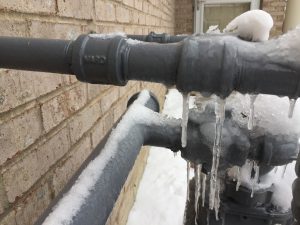This post in the next paragraphs about Preventing and dealing with frozen pipes is incredibly remarkable. You should look it over.

Winter can damage your plumbing, specifically by freezing pipes. Below's how to stop it from happening and what to do if it does.
Intro
As temperatures decline, the danger of icy pipes boosts, possibly resulting in expensive repair services and water damage. Comprehending just how to stop icy pipelines is important for home owners in cool climates.
Prevention Tips
Insulating prone pipelines
Wrap pipes in insulation sleeves or use warmth tape to protect them from freezing temperatures. Focus on pipelines in unheated or exterior locations of the home.
Home heating strategies
Maintain indoor spaces adequately heated up, particularly locations with plumbing. Open cabinet doors to enable warm air to circulate around pipes under sinks.
How to determine frozen pipelines
Search for reduced water flow from faucets, uncommon smells or sounds from pipelines, and noticeable frost on revealed pipelines.
Long-Term Solutions
Structural adjustments
Take into consideration rerouting pipelines away from outside wall surfaces or unheated locations. Add additional insulation to attic rooms, cellars, and crawl spaces.
Updating insulation
Invest in top notch insulation for pipelines, attic rooms, and wall surfaces. Correct insulation aids keep constant temperature levels and minimizes the threat of icy pipelines.
Shielding Exterior Pipes
Yard hose pipes and outside faucets
Detach and drain garden hose pipes prior to winter. Install frost-proof spigots or cover outside taps with protected caps.
Recognizing Frozen Pipes
What creates pipelines to freeze?
Pipelines freeze when subjected to temperature levels below 32 ° F (0 ° C) for prolonged periods. As water inside the pipes freezes, it broadens, taxing the pipeline wall surfaces and potentially triggering them to burst.
Risks and problems
Frozen pipes can lead to water supply disturbances, residential or commercial property damage, and costly repairs. Burst pipelines can flooding homes and cause considerable structural damage.
Indicators of Frozen Pipes
Determining icy pipes early can prevent them from breaking.
What to Do If Your Pipelines Freeze
Immediate activities to take
If you suspect frozen pipelines, maintain faucets available to alleviate pressure as the ice melts. Make use of a hairdryer or towels taken in hot water to thaw pipelines slowly.
Verdict
Avoiding frozen pipelines requires proactive steps and fast reactions. By understanding the causes, signs, and preventive measures, house owners can shield their pipes during cold weather.
6 Proven Ways to Prevent Frozen Pipes and Protect Your Home
Disconnect and Drain Garden Hoses
Before winter arrives, start by disconnecting your garden hoses and draining any remaining water. Close the shut-off valves that supply outdoor hose bibs and leave the outdoor faucet open to allow any residual water to drain. For extra protection, consider using faucet covers throughout the colder months. It’s also important to drain water from any sprinkler supply lines following the manufacturer’s directions.
Insulate Exposed Pipes
Insulating your pipes is an effective way to prevent freezing. Pipe insulation is readily available at home improvement stores and is relatively inexpensive. Pay close attention to pipes in unheated areas such as the attic, basement, crawl spaces, or garage. Apply foam insulation generously to create a buffer against the cold. You can also wrap your pipes in heat tape or thermostat-controlled heat cables for added warmth.
Seal Air Leaks
Inspect your home for any cracks or openings that could let in cold air. Seal any holes around the piping in interior or exterior walls, as well as the sill plates where your home rests on its foundation. Additionally, make sure to keep your garage door closed unless you’re entering or exiting. Leaving it open creates a significant air leak that can lead to frozen pipes.
Allow Warm Air Circulation
During cold snaps, it’s essential to allow warm air to circulate evenly throughout your home. Leave interior doors ajar to promote better airflow. Open kitchen and bathroom cabinets to help distribute heat consistently around the rooms. If you have small children or pets, be sure to remove any household chemicals or potentially harmful cleaners from open cabinets for safety.
Let Faucets Drip
A small trickle of water can make a big difference in preventing ice formation inside your pipes. When temperatures drop significantly, start a drip of water from all faucets served by exposed pipes. This continuous flow helps prevent the water from freezing. Additionally, running a few faucets slightly can relieve pressure inside the pipes, reducing the chances of a rupture if the water inside does freeze.
https://choateshvac.com/6-proven-ways-to-prevent-frozen-pipes-and-protect-your-home/

I discovered that piece of writing on How To Avoid Freezing Pipes when browsing the web. Those who liked our article plz remember to pass it around. Thank you for your time. Please come visit our site back soon.
Article